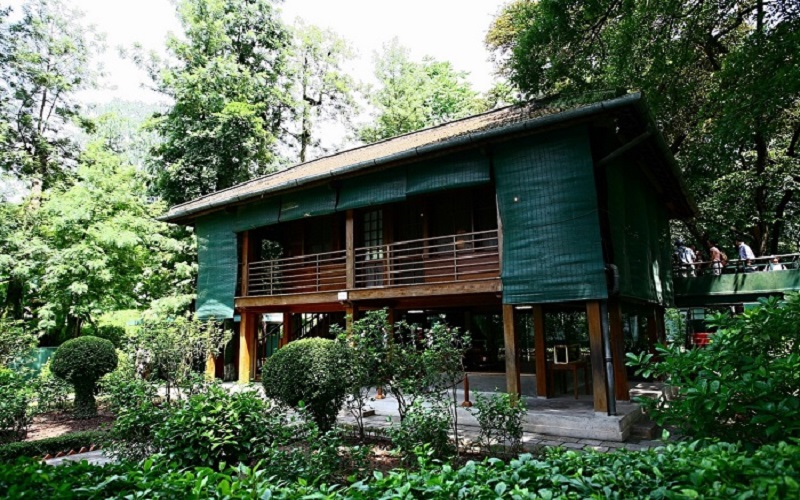Ho Chi Minh Stilt House: History, Architecture, Opening Time
Ho Chi Minh ’s Stilt House is one of the most visited places in Hanoi. As a symbol of capital city, this was where the First President of Vietnam used to live and work. Here, you will have a glimpse into the great life of Ho Chi Minh and a part of the heroic history of Vietnam.
- Location: No 1P Ngoc Ha Street, Đội Cấn, Ba Đình District, Hanoi City, Vietnam
- Opening Hours: 7:30 AM – 11.00 AM and 1:30 PM – 4.00 PM (Except Mon & Fri)
- Entrance Fee: Free of charge for Vietnamese, and 25.000vnd/ ticket/ foreigner
- Dress Code: Comfortable clothes to cover your shoulders & knees for respect
1. Where is Ho Chi Minh 's Stilt House in Hanoi Located?
Ho Chi Minh’s Stilted House is situate, in the Ho Chi Minh Complex on Ngoc Hoi Street, Ba Dinh District, Hanoi, near Ho Chi Minh Mausoleum. This was the place President Ho Chi Minh, the first president of Democratic Republic of Vietnam lived and worked for his last 10 years from 1958 until his passing in 1969.

Uncle Ho’s Stilt House, located in the heart of Hanoi capital city, is as modest and simple as the president himself. It preserves a lot of memories from the time he lived and worked here, especially in his last 10 years.
2. History and significance of Ho Chi Minh's Stilt House Hanoi
When the peace of Northern Vietnam was restored in October 1954, President Ho Chi Minh returned to Hanoi from Viet Bac War Zone. He relocated to the Presidential Palace at the end of December of the same year, where he remained until his passing. The Presidential Palace is a special national relic complex, having 16 large and small buildings. Among them, Uncle Ho's Stilt House is an outstanding work.

During a visit to Dai Tu District in Thai Nguyen Province, Ho Chi Minh expressed his desire to stay in a stilt house that resembled the traditional house of the Tay - Thai ethnic group in Viet Bac. He also wanted the house to be built next to the fish pond in the Presidential Palace.
Uncle Ho then met an architect named Nguyen Van Ninh. Together, they constructed a modest two-storey wooden house on stilts. The house was finished on May 17, 1958, just in time for Ho Chi Minh's birthday anniversary. From then on, the house became his official home.

After Ho Chi Minh ‘s passing away in 1969, the Vietnamese government decided to preserve the house so that people may visit and see it. This place welcomes thousands of local Vietnamese visitors and international tourists every year.
3. Architecture of Ho Chi Minh's Stilt House in Hanoi, Vietnam.
True to Uncle Ho’s wish, his house was made to resemble the traditional house of said minority ethnics in Viet Bac. It stands behind the main building of the Presidential Palace. Next to it is the fish pond and the lovely garden that Uncle Ho used to cherish. All of this has created a tranquil and fresh atmosphere for the stilt house.

The house is 10.5 meters in length and 6.3 meters in height. It has two floors with a wooden tilted roof and 2 rooms (working room and bedroom). The first floor only consists of stairs and columns and has no walls nor rooms. The floor was served as the reception to meet officials in the Politburo or to intimately receive a number of domestic and foreign delegations.
Going up the stairs, you will see a living room where Uncle Ho and key government officials used to have meetings. This was also his personal office during summers. Here, you will also see a bedroom and a workroom divided by a bookshelf. Each room is about 10 square meters wide, equipped with Uncle Ho’s essential furniture.

The fish pond is also a highlight of Ho Chi Minh’s Stilt House. This is where Uncle Ho usually spent his time after work, feeding the fish and enjoying the peaceful ambiance. Surrounding the house are various fruit trees and fragrant flowers. Coming here will definitely bring you relaxation, a temporary getaway from the hustle and bustle of city life.
4. Directions and How to Get to Ho Chi Minh Stilt House?
To get to Ho Chi Minh ’s Stilted House, there are many means of transportation you can use, from motorbike to public bus or walking on foot. If you go by motorbike, there are various routes you can take. The easiest way is to put the destination in Google Maps Directions and see which route is the shortest and most convenient for you. There are two parking areas for motorbikes if you driver there on your own: 1 in Ong Ich Khiem Street, opposite Ho Chi Minh Mausoleum Guard High Command - 2 in Ngoc Ha Street, at the entrance of Ho Chi Minh Museum.
Recommended Tours:
See Related Articles:

Best of Vietnam

Best Vietnamese Food You Have to Try in Vietnam
Best Food in Vietnam: Vietnamese Traditional Food is top World well known to be both healthy and...

10 Best National Parks in Vietnam
Vietnam Travel Guide: If you look for the Best Wildlife Discovery Experience in Vietnam, here are...
Read More
Best Souvenir to Buy in Vietnam
If you look for Best Things to Buy when traveling to Vietnam to bring home for your family & friends...
Read More
The 10 Best Places to Visit in Vietnam
Vietnam Travel Guide: Home to an extensive collection of historical and cultural attractions,...
Read More
Top 10 Museums You Should Not Miss in Vietnam
Vietnam, 4.000 years old country has a unique and lengthy history, culture with 54 ethnic groups. It...
Read MoreFind your trip
Vietnam Best Tours
Vietnam Car Rental
Vietnam Travel Blog
- Vietnamese People: Origin, History, Culture and Traditions
- Vietnam Currency: Best ATM and Places to Exchange Money
- Vietnam Map: Regions, Cities & Provinces Map of Vietnam
- What is illegal Things in Vietnam: Rules & Laws for Tourists
- Best Time to Travel to Vietnam to Avoid the Bad Weather
- Vietnam News: Population & Religions of 54 Ethnic Groups









